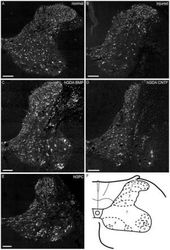
Researchers from the University of Colorado School of Medicine and the University of Rochester Medical Center have found a way to repair damage to the nervous system of rats and help restore their locomotor function as well through the use of a particular type of human cell.
Chris Proschel, Ph.D., study leader and assistant professor of genetics at the University of Rochester Medical Center, along with Stephen Davies, Ph.D., associate professor in the Department of Neurosurgery at the University of Colorado School of Medicine, and a team of researchers, have discovered a human cell that is produced from stem cells and placed into spinal cord-injured rats in order to repair nerve damage and restore certain functions.
The type of human cells used were human astrocytes, which are support cells in the central nervous system. These particular human astrocytes used were generated from stem cells called human fetal glial precursor cells, which were isolated and exposed to signaling molecules that instructed "different astrocytic cell fate." This process, which consisted of switching on or off signals in cells, created two types of human astrocytes -- BMP (bone morphogenetic protein) and CNTF (ciliary neurotrophic factor). One of the astrocytes was able to aid in the recovery of rats with spinal cord injuries while the other did not.
"Our study is unique in showing that different types of human astrocytes, derived from the exact same population of human precursor cells, have completely different effects when it comes to repairing the injured spinal cord," said Davies. "Clearly, not all human astrocytes are equal when it comes to promoting repair of the injured central nervous system."
The BMP human astrocytes proved to be beneficial to rats with spinal cord injuries. When transplanted into the rat, BMP human astrocytes provided up to a 70 percent increase in protection of spinal cord neurons that are injured. This helped support nerve fiber growth and the recovery of locomotor function. On the other hand, CNTF astrocytes did not have these benefits.
"It is estimated that astrocytes make up the vast majority of all cell types in the human brain and spinal cord, and provide multiple different types of support to neurons and other cells of the central nervous system," said Davies. "These multiple functions are likely to all be contributing to the ability of the right human astrocytes to repair the injured spinal cord."
The next step in this research is to test the transplanted human astrocytes in various injury models, and eventually use these cells in human models.
"We've shown in previous research that the right types of rat astrocytes are beneficial, but this study brings it up to the human level, which is a huge step," said Proschel. "What's really striking is the robustness of the effect. Scientists have claimed repair of spinal cord injuries in rats before, but the benefits have been variable and rarely as strong as what we've seen with our transplants."
This study was published in PLoS One.



Reader Comments
to our Newsletter